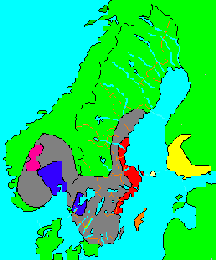|
Two Parnassius species
There are two species of the Parnassius
family breeding within Scandinavia, namely Parnassius apollo
and Parnassius mnemosyne. Both these are given names
by Linnaeus. Already
during his stay on the island of Gotland summertime 1741, he observed
at Torsburgen a large number of a big white butterfly, which according
to Linnaeus' documentation during the journey, already was described -
even on pictures - from the Alps by the English scientist James Petiver
(1665-1718). Common name until then was simply Alp butterfly.
| Here are
his Latin words after the investigation of a male specimen,
July 3, 1741:
Papilio
hexapus, alis erectis rotundis integerrimis albis, inferioribus ocellis
quatuor superne, septem inferne.
(Transl.
A six-footed butterfly, equipped with erect rounded wings completely
white, hindwings have four eyespots on the upper side, seven (spots)
underneath
|
1. Parnassius apollo Carolus von Linnaeus 1758
A
GLIMPSE OF IT'S HISTORY
Linnaeus
described the apollo butterfly as not common within Sweden and very
rarely recorded from abroad. The extension range of apollo is
widespread from the Alps to the mountainous areas of Asia. Nowadays
apollo in Europe has declined rapidly and has become even more rare or
endangered in the following European countries:
Albania, Austria, Bosnia, Bulgaria, Croatia, Czech Republic, Slovakia,
Finland, France (two ssp. are unfortunately extinct), Germany
(ssp. ancile is extinct), Greece, Italy, Liechtenstein, Netherlands,
Norway, Poland, Romania, Serbia, Spain, Sweden, Switzerland, Ukraine
and Russia.
Present distribution
The species Parnassius apollo is described in more than 160 different
subspecies, some named quite recently. Most ssp. are concentrated in
the Alps but some ssp are located in remote areas in Asia as far as
Mongolia and even China.
The Parnassius apollo is only one species of the
numerous Parnassiinae family. In 1988 this butterfly family
contained 39 species, all the subspecies not included. Most members of the Parnassiinae occur in Asia but
three species can be found in North
America, eversmanni, phoebus and clodius. In Europe apollo,
phoebus, mnemosyne breed and so does the false apollo, archon apollinus. A variety of foodplants is
accepted by the members of the Parnassius family. Concerning the apollo
species, larvae will feed exclusively on stonecrops such as
Sedum telephium and Sedum album. Most members of the parnassians are
found in rocky and mountainous areas, but there are some exceptions. For instance Parnassius mnemosyne loves humid
meadows in low woodlands.
Conservation measures
Apollo is protected by law in most countries of Europe. Why has apollo
declined? The causes are probably not properly understood. There are a
lot of theories on this matter such as climatic changes, acide rain,
impact of modern agriculture, overcollecting by entomological
enthusiasts etc. Whatever the causes are, the effects are dramatic -
the apollo has disappeared from several parts of its earlier breeding
areas.
Parnassius apollo breeding
It is quite easy to breed the apollo. In fact, there are many reasons
to breed rare butterflies. Specimens could be set out in the wild to
restore destroyed populations, the limited wild populations might be
protected from itchy collectors if there were bred specimens available
for collections. Much
knowledge and fascination could be achieved by observing the life cycle
of this beautiful and most striking insect.
In the opus Systema
Naturae of 1758 Linnaeus has officially named the butterfly Parnassius
apollo.
Distribution
map of P apollo and its ssp. in Sweden, Norway and
parts of Finland
  Estimated distribution
of P. apollo in the beginning of the 20th century Estimated distribution
of P. apollo in the beginning of the 20th century
 Present
maximum distribution of nominate apollo Linnaeus 1758 Present
maximum distribution of nominate apollo Linnaeus 1758
 Present
maximum distribution of ssp. fennoscandicus Bryk 1911 Present
maximum distribution of ssp. fennoscandicus Bryk 1911
 Present
maximum distribution of ssp.norwegicus Menthe 1912 Present
maximum distribution of ssp.norwegicus Menthe 1912
 Present maximum distribution of ssp. linnei Bryk
1913 Present maximum distribution of ssp. linnei Bryk
1913
 Present
maximum distribution of ssp. jotunensis Opheim 1945 Present
maximum distribution of ssp. jotunensis Opheim 1945
Different
ssp of P apollo are listed on this
page
Photographs of
P apollo is shown here
2.
Parnassius mnemosyne Linnaeus 1758
Syst. Nat. 1:465 Ed. 10
Nominate mnemosyne is originally described from
Finland, where also ssp perkele Bryk, 1921, is breeding. Estonia,
Latvia and Lithuania keep several populations and subspecies. In Norway
occurs ssp atlantica Opheim, 1949. Sweden keeps three ssp: ssp argiope
Fruhstorfer, 1917, ssp romani Bryk, 1922 and ssp nordströmi,
Bryk 1940. These breeding locations are situated far from each other
and have no connections. Mnemosyne eggs hibernate and hatch usually in
April when the temperature for a day or two exceeds plus ten
Centigrades. Mnemosyne larvae accept several Corydalis ssp. The adults
are normally on wing from June to middle of July. At least in Sweden
mnemosyne has declined rapidly and disappeared from its earlier
extension areas in mostly coastal places. The argiope population is
extremely small and at a risk of extinction. Ssp bang-haasi , Bryk
1912, in Denmark is unfortunately already extinct. Several measures
have been taken to save this rare butterfly in Scandinavia. When a
population diminuishes, probably the most severe thing is weakening of
the genes. To breed this particular species requires much care
and experience. The larvae accept several kinds of Corydalis, mostly
they eat the leaves day and night and grow very fast. When the larva is
going to pupate, the foodplant often already has withered. If you want
to know more about mnemosyne, please, go to this
page.
|